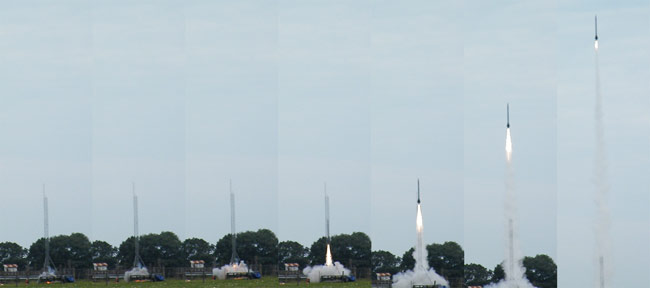New Rocket Fuel Mixes Ice and Metal

Rocket propellant has barely changed in the more than 50years since the launch of the first artificial satellite Sputnik. But a new mixtureof nano-aluminum powder and frozen water could make rocket launches moreenvironmentally friendly, and even allow spacecraft to refuel at distantlocations such as the moon or Mars.
The aluminum-ice propellant known as ALICE gets its kickfrom a chemical reaction between water and aluminum. Researchers hope that thehydrogen products of that reaction might go beyond launching rockets, and alsofeed hydrogen fuel cells for longduration space missions.
"In the bigger picture, we're looking at technologythat can store hydrogen long term," said Steven Son, a professor of mechanicalengineering at Purdue University. "Water is a nice, stable way to storehydrogen."
Both NASA and the Air Force Office of Scientific Researchhave shown enough interest in the concept to fund initial rocket firing tests.The research teams at Purdue and Penn State University used ALICE to successfullylaunch a rocket to 1,300 feet during an August flight test.
Such technology may not see action for some years to come,or at least until NASA sorts out its space exploration plans. But the recentconfirmation of watersources on the moon and Mars may hint at a future where ALICE and similarrocket propellants become highly practical.
Nano-aluminum arrives
Aluminum already represents a small but critical part ofmany rocket fuels, including the propellants for the space shuttle's solid boosterrockets and NASA's next generation Aresrockets. The metal's high ignition temperature of more than 6,920 degrees Fahrenheitforces exhaust gases out at high velocity to propel rockets upward.
Get the Space.com Newsletter
Breaking space news, the latest updates on rocket launches, skywatching events and more!
ALICE squeezes even more out of the aluminum by usingnano-scale particles with diameters of 80 nanometers, or 500 times smaller thanthe width of a human hair. Such tiny particles combust more rapidly than largerparticles to give an additional kick, and may allow easier control over arocket's thrust.
"The nano-scale aluminum is really key to making systemwork," said Timothee Pourpoint, a professor in the school of aeronauticsand astronautics at Purdue. "Using only micron-sized aluminum powder andwater ice would not have worked."
Researchers have tossed around theoretical calculations ofusing just aluminum and water for rocket propellant in the past. But the Purdueand Penn State teams took advantage of the relatively new nano-aluminum totranslate the concepts into reality.
"There have certainly been previous research efforts withnano-aluminum and water," Son told SPACE.com. "This effort isthe first time that anyone has actually launched a rocket."
Ice might suffice
The aluminum burning at extreme temperatures represents justone part of the ALICE equation. The other includes the oxygen and hydrogenlocked within water molecules that help feed the aluminum combustion.
That reaction produces products in the form of hydrogen gasand aluminum oxide, which may prove greener than existing rockets. Current spaceshuttle flights release about 230 tons of hydrochloric acid in the exhaustleft behind by their solid rocket boosters.
Creating the proper mix of ALICE propellant proved tricky,but the researchers ended up with slurry that some describe as being liketoothpaste.
"To produce an adequate mix, we wanted to mix it usinga machine, not mix it by hand with a spatula," Son recalled. "Ifyou're going to scale up propellant processing, you up have to automate themixing."
The freezing helped keep the propellant intact during thefirst test launch, as well as prevent any premature aluminum-ice reactionscaused by accidental sparks, or slow oxidation from occurring.
Moving on up
Success aside, the researchers have already turned theirthoughts to the new ALICE mixtures that can boost performance beyond that ofexisting rockets.
"We're at or slightly below conventional solidpropellants in terms of overall performance," Son noted. But he added thatthe team had made "conservative choices" to ensure that the firstflight showing proof of concept went smoothly. Now they can push the envelope.
Perhaps the most immediate idea involves mixing nano-aluminumwith larger aluminum particles. That could allow more efficient use of thealuminum, and cut back on the amount of wasted aluminum oxide in the initialaluminum.
The researchers are also working with more energeticaluminum-water mixtures as they initially chose a mixture with extra ice to erron the safe side. Their caution came at the cost of lower exhaust gastemperatures during launch, which translated into lower performance and lesshydrogen produced.
"We are thinking about another launch with a differentcomposition of aluminum-ice propellant," Pourpoint said. "We know wecan adjust the ratio between the two components as well as add components toimprove performance."
Future work might even look at creating gelled propellantthat behaves like liquid fuel. New mixtures could also produce more hydrogen,and take a step closer to helping run hydrogen fuel cells.
But both Son and Pourpoint emphasized a more immediatebenefit from ALICE ? giving more than a dozen undergraduate and graduatestudents the chance to translate scientific concepts into a realrocket launch. Getting to help pioneer a future phase of space explorationdoesn't hurt, either.
- Video - NASA's Ares I-X Test Flight Unveiled
- Video - See the Ares I Rocket Motor Test
- Video Show - NASA's Vision for Humans in Space
Join our Space Forums to keep talking space on the latest missions, night sky and more! And if you have a news tip, correction or comment, let us know at: community@space.com.
Jeremy Hsu is science writer based in New York City whose work has appeared in Scientific American, Discovery Magazine, Backchannel, Wired.com and IEEE Spectrum, among others. He joined the Space.com and Live Science teams in 2010 as a Senior Writer and is currently the Editor-in-Chief of Indicate Media. Jeremy studied history and sociology of science at the University of Pennsylvania, and earned a master's degree in journalism from the NYU Science, Health and Environmental Reporting Program. You can find Jeremy's latest project on Twitter.









